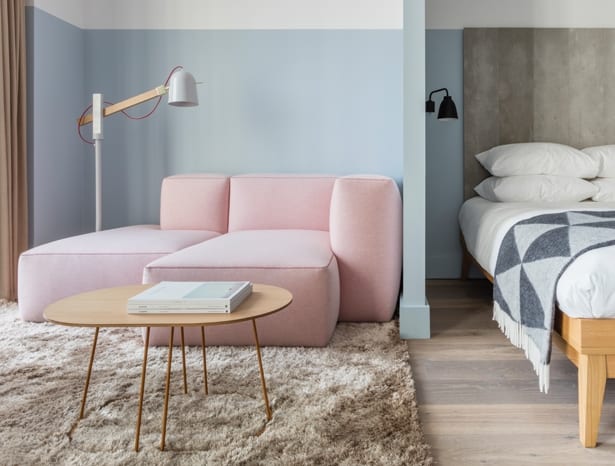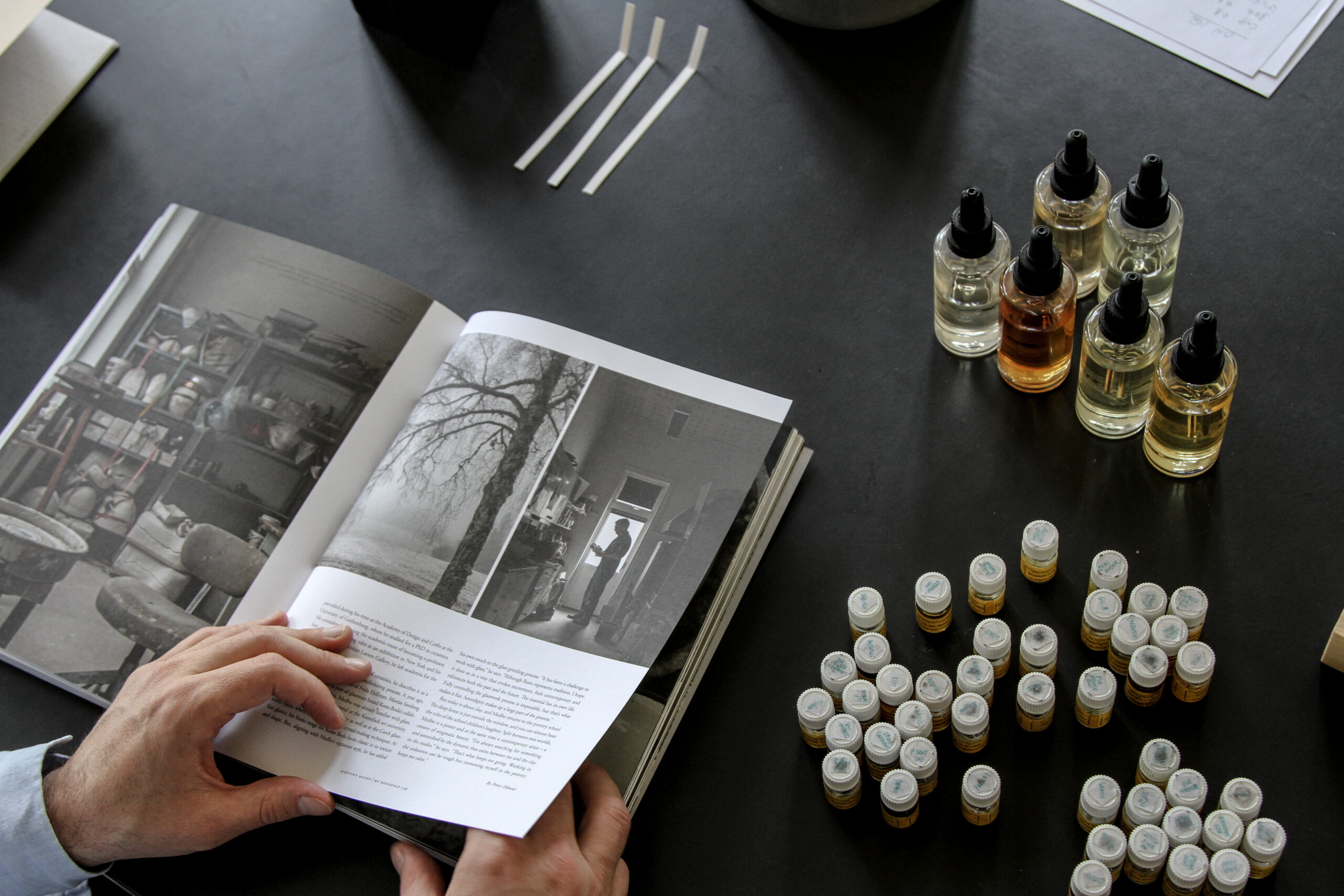 Leman Locke’s bespoke L-shaped sofa|||
Leman Locke’s bespoke L-shaped sofa|||
Aparthotels are one of the fastest growing hospitality sectors and innovative accommodation design is reinvigorating the industry. OnOffice has documented the rise of adaptable office and co-working space and it seems that modern travellers – and tenants – are on the lookout for equal flexibility and choice in their leisure spaces.
The rise of aparthotels or serviced apartments is likely a response to the savvier traveller, in the era of Airbnb, as well as to the evolving “bleisure” (mixing business and leisure) market. Hotel guests are seeking opportunities to immerse themselves in the spaces they frequent, looking for living and cooking spaces as well as bedrooms, and wanting to experience new neighbourhoods in the way that locals do. Meanwhile, young professionals are searching for convenient, mixed-length-stay apartments that can cater to the growth of the “gig economy” – whereby increasing numbers of young workers are accepting short-term freelance jobs, working and networking in various locations.
This need for flexibility requires original design concepts, with architects and interior designers around the globe challenging the norms of traditional hospitality design. Leman Locke is a new brand that combines the best of boutique hotels (style and personality) and of serviced apartments (autonomy and comfort). Launched this November, the design-led aparthotels come from the Serviced Apartment Company and were designed by Grzywinski + Pons.
 Design touches at Leman Locke
Design touches at Leman Locke
“Leman Locke was designed, essentially, for me. By that I mean I conveniently fit the presumptive target demographic,” Matthew Gryzinski tells me. “We had in mind that young, creative professionals who are increasingly nomadic for purposes of their work might like to have an option that combines the best of a few worlds from a hospitality perspective… A way to hold on to the romance or aspirational excitement of a hotel stay while enjoying the advantages of having something more akin to a home in one’s adoptive city no matter how long – or short – the stay.”
The first Leman Locke is located in London’s East End. Guests might stay anywhere from one night to a year and can enjoy bigger live/work spaces and appealing communal areas. Its 171 suites are almost double the size of a typical hotel room, and start at a generous 30sqm.
The layout of the apartments revolves more around the living area than the bed; it’s a place for living and sharing, not just for sleeping. Each suite comes fitted with a kitchen and floor to ceiling windows and Gryzinski created an “implicit divide” between the living and sleeping areas.
“While it feels indulgent (in a good way) to live and work out of a bed in a hotel room, we all know for longer stays that doesn’t encourage the healthiest habits or best sleep,” he explains. “Like an apartment, the tables or sofas become options for in-room work or relaxation. Our rooms are an attempt to mine the best respective aspects of the hotel room-apartment spectrum.”
 Mercedes-Benz’s Kensington studios
Mercedes-Benz’s Kensington studios
The furnishings were designed bespoke by Grzywinski + Pons, including Locke’s signature L-shaped sofa and the Locke bed, light fixtures and tables: “Some of that was driven by the desire to create a unique and harmonious aesthetic, but the other design imperative was maximisation of function and economy of space,” he says.
“We really wanted to avoid the ‘transformer’ vibe apparent in a lot of other micro residential products now that include Murphy beds and flip-up tables etc. Not to disparage that, but while it often appeals to the ‘inventor’ side of us as architects, I find that the last thing people – including myself – want to do when finishing a meal or getting ready for bed is to clear up and manipulate the furniture in one’s room.”
Grzywinski has noted the growing demand for aparthotels and serviced apartments but tells me that he also likes to think “we are at least among the first to prioritise the design-led aspect of such products. I do know when I was perhaps unwittingly looking for such a product for myself I could find none, so I hope that is a good sign.”
 Mercedes-Benz’s hi-tech Black Magic Wall
Mercedes-Benz’s hi-tech Black Magic Wall
Another brand to respond to this growing market is Mercedes-Benz, which piloted its own project based on the brand’s luxurious design philosophy. Commissioned by Mercedes-Benz Style and Frasers Hospitality Group, the first Mercedes-Benz Living @ Fraser spaces were created by JOI-Design. Their serviced residences were opened in London’s Kensington at the end of 2015; others have just been launched in Singapore.
The apartments are comfortable and elegant homes away from home and feature clear, simple lines of design. “On the one hand, Mercedes expected an extraordinary design which would fit with the luxury hallmarks of the brand’s automobiles,” says Corinna Kretschmar-Joehnk of JOI-Design. “But on the other hand, Frasers, as the operator, expected high functionality and ease of maintenance from the design.”
Each studio comprises a bright living and dining area, fully equipped kitchen and two spacious bedrooms. In the living room a specially designed “Black Magic Wall” offers state-of-the-art hi-tech entertainment while bespoke Swarovski chandeliers provide beautifully lavish mood lighting. Glossy black surfaces and shimmering silver are teamed with sculptural furniture to emphasise the luxurious feel of the spaces.
 Manuelle Gautrand’s Hipark hotel in Paris
Manuelle Gautrand’s Hipark hotel in Paris
In Paris, the Hipark hotel by Manuelle Gautrand Architecture, with interior design from Didier Gomez, shows that a well-designed aparthotel needn’t feel exclusive or lavish – and can be created within even the most challenging of urban spaces. This project, on its complex triangular site, was part of a larger development along Paris’ northern edge with three independent adjoining buildings: an office building, a student residence and the hotel.
“I decided to seek continuity with the adjoining building, namely Jacques Moussafir’s student residence, which is why the hotel resembles an impressive, jutting prow of some vast, multi-coloured ship,” explains the building’s architect, Manuelle Gautrand.
The practical design offers a wide range of uses within its modern, uplifting facade. “The environment was the main inspiration,” says Gautrand. “The colour of the facade is broken up into horizontal strips that gradually fade from the dark greens of the surrounding foliage to the pale blue and white tones of the Paris sky.” Inside, Didier Gomez designed three apartment types: studios with living and office spaces, a kitchen and double or twin beds, larger business studios and two room apartments of 26-32sq m.
 Didier Gomez’s bright interiors for the Hipark
Didier Gomez’s bright interiors for the Hipark
Another brand to watch is JO&JOE. Developed by Accorhotels and aimed at millennials, it plans to open its first hotels in 2017 and to have 50 venues around the world by 2020. Accorhotels has released visuals of the hotel designs from Penson and it certainly looks like an innovative take on hospitality design.
Penson CEO Lee Penson describes JO&JOE as a “new model… open, on budget, comfortable & luxurious, sociable, and so many different elements rolled into one.” Its “Yours” spaces are rooms and apartments for two to five people, while “OOO!” (Out Of the Ordinary) will provide quirkier accommodation for people travelling alone or in groups of up to six. Instead of apartment-style kitchens, JO&JOE will offer “collaborative kitchens” where guests will be able to cook and socialise.
 JO&JOE’s flexible modular furniture
JO&JOE’s flexible modular furniture
The brand’s “Together” is an innovative modular sleeping area that will allow guests to hack and alter the spaces they stay in. “This is the very cool bit,” says Penson. “The unique Kit-of-Parts movable furniture caters for any size group or positioning, as everything is on wheels – including the beds… The entire space facilitates meeting of people and creating experiences.”
As a growing market asks for more freedom and experience, the lines between hotel, apartment and workspace will be continually blurred. Is this adaptability the future of hotel design?, I ask Penson. “I believe it to be, yes,” he says. “I have stayed in the world’s best & worst hotels for work & fun… what has struck me is that I always find they aren’t flexible or adaptable enough for modern life.”
 JO&JOE’s Solo Social for independent travel
JO&JOE’s Solo Social for independent travel
A new wave of design-led aparthotels offer flexibility and privacy to echo the changes in the way we work























